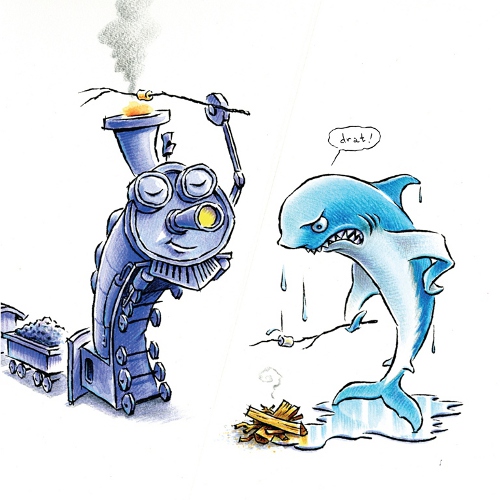Illustrated by Howard McWilliam
(Flashlight Press, 2011)
It’s easy to get lost in one’s imagination when building a
sandcastle. Some of us just get more
blessedly lost than others. Indeed, the unnamed boy in When a Dragon Moves in would assert that imagination is not at play
at all—his beach encounter is entirely real.
When the boy’s family arrives at the beach, he constructs a perfect
sandcastle and, naturally, a dragon takes up quarters. [Dragons have good taste
after all. And castles are so much more inviting when they are free of knights
and distressed damsels.]
The boy and the dragon have a grand time playing together. Turns
out that, in addition to their inherent marshmallow-toasting abilities, dragons
make good rafts when it’s time to cool off in the water. Despite having the
most awesome beach buddy ever, the boy eventually seeks his family’s attention.
Shockingly, they are not the least bit interested in the dragon. They don’t
even believe there’s a dragon. When
the boy implores his mother to listen to the fierce creature, she doesn’t even
look up from her beach read as she says, “I hear the roar of the ocean.”
Hmmph.
Things get even worse when the boy gets blamed for the
dragon’s deeds. Take, for instance, the fingerprints-on-all-the-brownies
episode. Why those aren’t fingerprints
at all! How can anyone be unaware that dragons LOVE brownies?! With the boy getting
all the blame for every infraction, he must reconsider whether his perfect sandcastle,
along with its new resident, is worth the trouble.
I picked up this book after a class at my school developed
an interest in creating kingdoms and communities in a sand pit at our school.
They delighted in this picture book and agreed to disagree by book’s end as to
whether the dragon was indeed real or a product of the boy’s imagination.
McWilliam’s pencil drawn, digitally painted images perfectly
portray the sights of summer and children will instantly befriend the highly
expressive red dragon. (As much as McWilliam tries to make the boy an endearing
character as well, the character is always overshadowed by the larger than life
dragon.) Adults, in turn, will enjoy the realism depicted of a day at the beach
and the family’s interactions.
Like Mattland,
When a Dragon Moves in is a
celebration of the kind of imaginative play that arises from a small plot of
sand or dirt. It’s worth a read.



